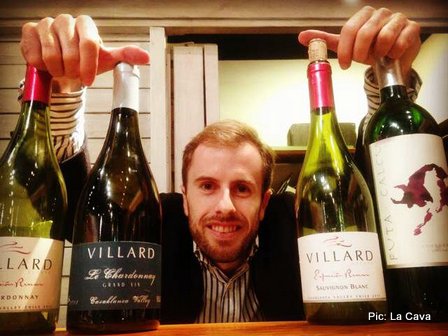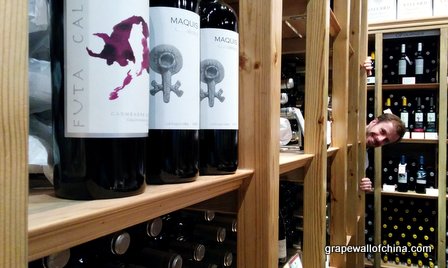
By Jim Boyce
Wine from Chile is considered a fruity and inexpensive option in China. That’s not a bad thing, given Chile provides good value, but native Mariano Larrain Hurtado hopes to get people drinking what are considered some of the country’s better wines.
His shop La Cava de Laoma is based in the Sanlitun area of Beijing and focused solely on Chilean wine, with a range of brands — including some, such as Maquis and Calcu, made by his family — that start at just under rmb100. I asked him a few questions about his experiences at the shop and his take on the China wine market.
From Shanghai to Qingdao to Chengdu, there are big differences in the wine markets of China. Why did you base your shop in Beijing?
I decided to base my operation in Beijing just because I had already been living here for three years — quite an emotional reason. I feel comfortable here, I more or less understand the city, and in a short time I became part of the local circle of wine professionals. I decided to live in Beijing because it is the capital of China and I find its history interesting.
Still, Beijing is far from Shanghai and some southern cities in relation to wine consumption and sophistication. That means big opportunities but also a huge amount of work. Maybe in my “next life” I will be reborn in Shanghai.
Who are your typical consumers and why do they buy your wines?
My business is fascinating because it is extremely complex in terms of the nature of my clients. My clients generally fall into three categories: foreigners who are looking for good value, which they can easily find in my portfolio, but who won’t buy expensive wines; Chinese who buy more expensive wines as gifts but who are usually one-time visitors and are decreasing in numbers in this market; and an interesting type of customer who is eager to learn more about wines but doesn’t have high purchasing power.
The last category of consumers is the one that requires the most attention because of the education process but it is the most rewarding because I can be part of the process of teaching about Chilean fine wines. These kinds of customers are growing in number and steadily consuming more wines. I also find they welcome the fruity style of many Chilean wines.
When it comes to consumers buying solely on taste, what wines do you find they prefer?
Among the red wines, Pinot Noir is a big success because of its fruitiness, and it is very appealing to the palate in the northern regions of China. However, Cabernet Sauvignon is still the king, mainly because it is more reknown as a grape variety. White sweet wines are very welcome among Chinese consumers and work quite well for pairing with Chinese food in general, especially spicy food. I’ll give a special mention to ice wine, which I see as having great potential even if it is quite expensive.
You have attended several trade fairs in China? How worthwhile have you found them?
It’s the traditional way of meeting new distributors but I’m not a big fan of wine fairs in China. The people attending them are not the right people, with some exceptions, such as the meetings at the Kempinski hotel during the Chengdu wine fair.
China is not a homogenized market. Every city represents a different market, with its own characteristics, so what might work in Qingdao might not work in Jinan, even though they are in the same province. I already learned that I can’t pretend to impress people with my wines but rather I need to try to understand their requirements.
I don’t agree when people say it’s time to move to second- and third-tier cities. Some of those huge cities are not consuming wines or in the best scenario they are consuming inexpensive wines, which I don’t provide.
What is the biggest lesson you have learned about the China wine market since opening your shop?
I’m importing some of Chile’s finest wines, ones that are expensive even back home. My cheapest wine costs around 75RMB (USD12) in Chile and I’m selling it for 85RMB (USD14) in Beijing. Even though I’m making a big effort to be competitive and provide high-quality wines, the market in north China is not prepared for these kinds of products. Most people are still buying less expensive entry-level wines, which I don’t have, or they focus on the presentation, such as the bottle and labeling, rather than quality.
The second big lesson, maybe a lesson for every wine business in China, is the close link between sales and government spending. Since the recent government crackdown on corruption, wine sales have dropped dramatically. Now the real Chinese wine consumers are finally emerging: young professionals that enjoy wines daily at home or with friends in a restaurant. But the results are far from the stratospheric numbers, in terms of prices and volumes, we were used to until about two years ago.
Unfortunately, I decided to start my business in the middle of 2012 when the government-focused market was at its peak. When I finally opened last year, I found a completely different market condition in which to sell the large quantity of excellent but far-too-expensive Chilean fine wines I imported. Now it is time to rethink my focus!
What one red wine and one white wine in your portfolio would you recommend to a beginner with a modest income? How about someone with a good knowledge of wine and some money to spend?
As a wine shop owner, I feel very uncomfortable recommending expensive wines to a new client. I prefer to recommend cheaper wines they might like so much that they return for more wines and I can start the education process through my portfolio. To a beginner in wine, I would recommend my family’s Calcu Sauvignon Blanc, which for 100RMB (USD16) is a great value. From the reds, I would recommend Villard Expresion Syrah for 119RNB (USD20), because it’s extremely well-crafted and fruity.
Three of the wines in my portfolio were selected as best in their categories in Chile, including best Cabernet Sauvignon, best Pinot Noir and best Cabernet Franc, so I’m very comfortable recommending any of them. However, I’m most proud of recommending my family’s extraordinary wine, Maquis Franco 2010, selected as Chilean best Cabernet Franc and which can easily compete in a blind wine tasting with any of most renowned Bordeaux chateaux. It’s not a secret that it is blended by Jacques Boissenot, a consultant to most of Bordeaux’s first growths.
Click here for the La Cava website.
Sign up for the Grape Wall newsletter here. Follow Grape Wall on LinkedIn, Instagram, Facebook and Twitter. And see my sibling sites World Marselan Day, World Baijiu Day and Beijing Boyce. Grape Wall has no advertisers, so if you find the content useful, please help cover the costs via PayPal, WeChat or Alipay. Contact Grape Wall via grapewallofchina (at) gmail.com.

Leave a Reply
You must be logged in to post a comment.